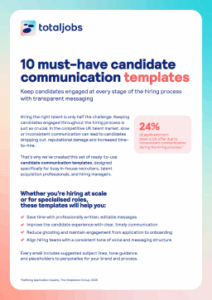
How to write an employee reference
Table of Contents
- What is a reference letter?
- Why is a reference letter important?
- How to write a reference letter
- Best practices for references
- FAQs

Candidate Communication Templates
Lots of employers receive regular requests for references from previous employees. Writing a positive reference letter for them can be invaluable for their career progression.
A great reference letter can be the difference between someone getting the role they want and it going to someone else. As an employer, you have a duty to provide this letter to your former employees, and there are plenty of benefits in it for you too.
In this article, we’re exploring the ins and outs of a well-written employee reference letter and why it matters.
What is an employee reference letter?
A reference letter for an employee is essentially an endorsement of a candidate’s skills and experience.
McKinsey asserts that 70% of frontline employees have applied for career advancement opportunities with their current employer or different companies, many of whom require strong references to secure new roles.
They don’t all have to be detailed character references that extoll the virtues of the employee. In fact, many organisations will only provide references that contain the basic facts, such as the dates the employee worked there and their job title.
The difference between a reference letter and a recommendation letter
Typically, a reference is a general letter prepared in advance for an employee to share with potential employers. A recommendation letter is usually a lot more specific and written at the request of a potential employer.
The two can in reality end up being the same and serving the same purpose, but a recommendation letter is much more forward and is not something that is expected or required in most cases.
Why is a reference letter important?
There are a number of factors that make reference letters important, for both the candidate in question and for you as an employer. For employees:
- A strong reference enhances their chances of securing a new role by providing valuable insights into their skills, work ethic, and contributions.
- In some cases, a reference is a requirement before they can officially start their new job.
- It helps ensure they leave your organisation on good terms, maintaining a positive professional relationship for the future.
For employers:
- Providing honest references reflects your organisation’s commitment to its people and plays a key role in succession planning.
- It fosters trust within your company, showing employees they are supported in their career growth—even if that leads them elsewhere.
- A structured approach to employee references, alongside exit interviews, strengthens your offboarding process and helps departing employees transition successfully.
- It enhances your employer brand by demonstrating professionalism and integrity, making your company more attractive to top talent.
- Offering positive references keeps the door open for former employees to return in the future, expanding your talent pool with potential “boomerang” hires.
Do you have to provide a reference letter?
There is no legal requirement for employers to provide references to an outgoing employee’s future place of work. However, if their contract specifies that a reference must be provided, the employer is obligated to do so.
In most cases, it’s not a good look to refuse to provide a reference, as doing so may damage your employer brand and discouraging future talent from joining your organisation.
How to write a reference letter for an employee leaving your organisation
Follow the steps outlined below to prepare comprehensive reference letters that meet candidate expectations whilst enhancing your brand as an employer.
1. Consider if you can produce a positive reference
First things first, should you even be writing a reference? Not every employer-employee relationship is perfect—sometimes, an employee may not meet expectations.
So, before even considering writing a reference letter, it’s important to think about whether you can provide a positive recommendation to support the candidate’s application. If not, it may be best to decline the reference request. It’s better to decline than to provide a negative reference, as this is discouraged.
If you decide to decline, you do not have to provide a reason, but you could say something like: “I’m sorry, but I don’t feel I have worked with you long enough to provide an accurate and thorough recommendation, but I wish you all the best in your job search.”
2. Address the reader directly
A reference letter should start with a formal and direct address to the recipient. If you have their name, always use it. If not, address it to the hiring manager of the company in question.
3. Clearly state your intentions
Be clear and concise, stating that this is a letter of recommendation for the candidate, where you will be endorsing their skillset.
4. Include the employee’s current or previous position
Detail how and when the employee worked for you. If they’re currently in your employment, state their job title, their relationship to you, whether that’s as a direct employee or part of a subordinate team, and how long they were with your company.
This will help to corroborate the candidate’s CV and/or cover letter.
5. Outline the candidate’s achievements and strengths
Be specific and include details of what the employee did well within your organisation and examples of when they excelled or exceeded expectations.
If you have a copy of the job description, you can relate any achievements you cover to the description, helping highlight how the candidate is a good fit for the role.
Wherever possible, you should provide clear examples of when and how the employee showed particular character traits or skills.
6. Summarise your recommendation
Use the final section of your letter to emphasise and reaffirm the key points you believe make the candidate a great choice for the role. Make sure you are assertive in your clear recommendation of the candidate.
For example, say you can ‘wholeheartedly’ recommend the employee if this is the case.
7. Provide your contact details
Always provide your contact information, including email address and phone number, so the recruitment team can get in touch if they want to find out more about the candidate or have any further queries.
It’s also good to sign the letter by hand to add extra validation to the reference.
Best practices for effective employee reference letters
The steps above cover the basics you need to write a reference letter. An effective reference letter should also adhere to the best practices outlined below.
Be specific
If you are providing a letter of reference for a specific role, then tailor it accordingly. This helps to show the hiring team that you’ve thought about the reference and prepared it specifically for their benefit.
Be positive
You should only give a reference if you’re able to be positive and recommend the employee. Positivity should be the overriding tone of the reference, and you should look to give examples that highlight the candidate’s strengths and attributes.
Be professional
Even if you have a good rapport with someone, don’t be too informal or emotional about their impending departure. You should recommend them professionally without including any irrelevant or unnecessarily personal information.
Be fair and accurate
References should be an honest reflection of why you would recommend the employee. You should keep things simple but fair and based on how well they worked while under your management or within your business.
Don’t be too brief or too wordy
A good recommendation letter can be nice and short, in the region of 300 words. If you want to go into more detail, try to keep it under 1,000 words as an absolute maximum. Any longer and you will lose the interest of the reader, any shorter and it may seem that you don’t have all that much positive to say about the employee.
Frequently asked questions (FAQs)
What is an employee reference letter?
It’s a document that endorses an individual’s skills, experience and character, helping them in securing new roles.
Why is providing a reference letter valuable?
A strong reference enhances the person’s job prospects, helps maintain goodwill, and reflects well on the organisation’s professionalism.
Do I have to write a reference?
What if I cannot provide a positive reference?
It’s better to politely decline than to write something neutral or negative. You do not need to disclose the reason, keeping it brief and considerate is acceptable.
Explore articles
Receive the latest recruitment resources and
advice to boost your hiring
By providing us with your details you agree to our privacy policy and for us to keep you updated with the latest news, events,
and special offers from Totaljobs.






